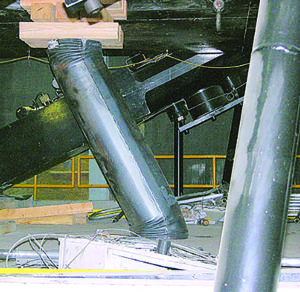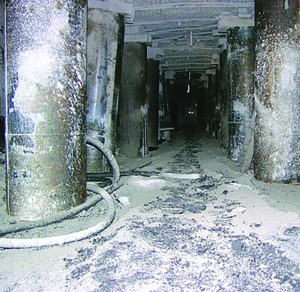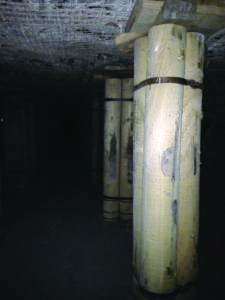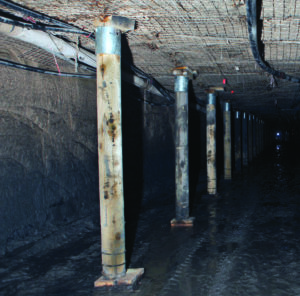
The CAN is cement in a cylindrical steel canister. It is available in diameters from 9 to 36 in. and can support 25 to 200 tons. (Photo: Burrell)
The most popular secondary roof support systems today offer ease of installation, dependability, versatility, and long track records to prove it
by jesse morton, technical writer
The established secondary roof support systems for headgate, tailgate and bleeder areas at the longwall face and elsewhere continue to be the most popular on the market, according to the biggest suppliers in the space. What has changed in some cases is new applications have been added over the years. What has not changed is the proven dependability offered by each of the solutions reviewed below.
Versatile and Resilient
Burrell reported the CAN is as popular now as it was during boom times.
“Since the mid-90s, the CAN has been and will remain a viable solution for longwall tailgate support,” said Aaron Wilson, vice president, sales and development, Burrell Group.
“The CAN stands the test of time,” he said. “Many of the nation’s leading underground coal producing mines relied on our supports during the industry’s prosperous times as well as challenging times.”
The company describes the CAN as a steel canister filled with cement. It is “a confined core of cementitious composite, encased in a cylindrical steel canister, which resembles a can,” Wilson said.
Flexible, it can be customized to the specifics of the application and is available in diameters from 9 in. to 36 in. “Ranging from as low as 25 tons of support to 200 tons, sizes and configurations have been developed for a range of applications,” he said.
“Generally, the product is adaptable to both hard and soft bottoms as well as loose or solid tops,” Wilson said. “In most mine applications, it is used for longwall tailgate support and establishing roof support controls in bleeder districts.”
Typically, it is not used for temporary support. Often, it goes in “ventilation courses that are intended to be maintained and used for
a considerable period of time,”
Wilson said.
The CAN was developed in the early 1990s and was based on an earlier solution described as a lightweight cellular block for underground construction. “Burrell, leaning on their manufacturing ability and proximity to mining markets, decided to proceed with using their Omega fill solution in a steel cylinder, thus creating the CAN,” Wilson said.
“The CAN was designed to meet the needs of mines with significant convergence and floor heaving while also solving combustion concerns with the use of mainly post-combustion materials,” he said. “It was designed with convergence expected, so it has the ability to yield further and longer than many other secondary roof supports.”
The CAN offers both strength and flexibility. “Controlled convergence is ideal when convergence is expected,” Wilson said. “The CAN has continually provided consistent, reliable yield that can be counted on time after time.”
With large populations in the U.S. and Australia, the solution has a storied history. Its versatility makes it an obvious choice for miners working in complex and varying ground conditions.
For example, a limestone mine in the eastern U.S. contacted Burrell for supplemental support solutions for a portal with several linear anomalies in the roof running perpendicular to the entry. “This portal was especially important due to the future installation of an inline mine fan,” Wilson said.
The challenges were complex. “There was very little overburden over the entry,” he said. “If the roof collapsed, the likelihood of losing hundreds of feet of the entry was probable.”
The entry was 30 ft tall and subject to outdoor weather. “The mine floor pitched between the ribs as well as going in-by,” Wilson said. “The roof pitched slightly in the opposite direction to that of the floor orientation.”
And the solution needed to be long term in a mine expected to produce for nearly a half-century.
“The team at Burrell Mining worked with mine management to design and provide a supplemental support system that alleviated the problems in the roof, and that fit into the less-than-optimal mine environment,” Wilson said. “The CAN offered a long-term solution with low resistance to the future mine ventilation system.”
The CAN is distributed by GMS Mine Repair and Maintenance. “With GMS as a partner, customers are now offered turnkey solutions with both products and installation,” Wilson said.
“In addition, our collaborative efforts allow for further innovation and solutions,” he said. “Research and development is already advancing between the two companies in an effort to supply more options to our existing products as well as identifying opportunities for new product development.”
Which furthers the company’s mission “to lead through innovation,” he said, “and to competently support those who extract raw materials from the earth for a living.”

The CAN often goes in ventilation courses that are intended to be maintained and used for a long time. (Photo: Burrell)
Reliable and Cost-effective
JENNMAR reported that the J-Crib pumpable support system ranks among the most popular secondary support solutions in North America, and that in the 2018 fiscal year alone, it pumped roughly 175,000 cribs in the U.S.
The solution is comprised of cement and a containment bag crib. The crib is situated in place and then pumped full of concrete from surface grout machines to form a support column.
The cement is partly “a non-combustible grey powder that forms an easy-to-pump slurry when mixed with water,” the supplier reported. That is mixed with “a non-combustible, low-viscosity, easy-to-pump liquid accelerator.”
The components “gel in less than 30 seconds, allowing the top of the crib to be pressurized against a stiff base,” JENNMAR said.
Jennchem also offers the grout bag cribs, said Adam M. Dutil, technical service engineer, Jennchem.
“The grout bag is a steel- or fiber-reinforced bag with a quick-connect coupling for ease of filling,” Dutil said. “The biggest advantage of this is pumping distance. We can confidently pump 15,000 ft horizontally from the bottom of a borehole to where cribs
are installed.”
Greater distances are possible when conditions are ideal, he said.
The solution is available in diameters from 24 to 30 in., and capable of supporting between 150 and 230 metric tons, JENNMAR reported.
The listed benefits are numerous. One of the topmost is the capability to be rapidly deployed and installed. “It takes approximately 10% of the trips for pumpable cribs when compared to traditional floor-to-roof supports,” Dutil said. “This is a huge advantage when considering the ever-rising cost of labor and supplies.” Jennchem supplies the labor for installation.
“The Jennchem pumpable crib system provides mines the opportunity to stay ahead of all the other work it takes to run an active mine by drastically reducing the strain on supply chain,” Dutil said.
“The rapid strength gain provides early resistance to mine roof convergence and bed separation,” JENNMAR reported.
The solution offers a “high yield, approximately 60% by water volume,” JENNMAR reported.
It offers “consistent performance with pressurization of bags ensuring good contact with mine roof and even load-bearing capacity,” JENNMAR said.
The biggest benefit, however, is cost savings, Dutil said. “In recent studies, we can conclusively prove that we are quite cost competitive with the more traditional floor-to-roof support systems,” Dutil said. “The ease of supply chain coupled with the labor it takes to set other supports makes Jennchem J-Cribs a very reliable, cost-effective way to support both longwall headgates and tailgates,” he said.
Pumpable cribs were developed mostly out of necessity, he said. “One of the main reasons that pumpable cribs were developed was strain on the supply chain as mines expanded,” he added.
Mines were getting bigger and were challenged to keep up with the longwall retreat, Dutil said.
“As mines became larger, it took longer to bring supplies in, thus becoming a burden for mine management to keep up with longwall support,” he said. “Ever-changing underground conditions coupled with the challenges of competing in today’s markets have demanded a better, more cost-competitive floor-to-roof support.”
Jennchem was established roughly a decade ago, and J-Crib quickly became the flagship product, Dutil said. “Of the main product groups that Jennchem provides, the J-Crib pumpable support system is the largest,” he added.
Several case studies have explained why. A more recent one showed the solution contributed to significant cost savings over the course of an entire longwall panel, Dutil said.
“In this particular instance, we found J-Cribs to be better because of initial stiffness compared to what the mine was doing before,” he said.
“As far as cost savings is concerned, we found that by installing J-Cribs in the same pattern, the mine would see a cost savings of approximately $750,000 in one panel,” Dutil said. “If the mine opts to switch the pattern a little bit to what we recommended, they could realize a cost savings of roughly $1 million.”
For installation, Jennchem personnel need a surface workspace of approximately 50 ft by 100 ft, and a turnaround for trucks.
“While pumping to keep up with longwall mining, we need about seven to eight deliveries of material per week,” Dutil said. “We require a power drop from the mine and we provide our own disconnect box.”
Power requirements are 400 amps, mostly for a water heater during the cool months.
“Prior to setting up, we also require a borehole with at least two 1.5-in. lines,” Dutil said. “This is what we use to pump material through.”
The experts that install the system offer technical services “unmatched in industry,” he said. “The quick response of our team to roof condition issues is unparalleled.”

The Cluster Prop, a timber roof support comprised of three Propsetters, can provide up to 200 tons of support. (Photo: Strata Worldwide)
Fast-acting and Strong
Minova reported its fast-acting Rappass dry-sprayed shotcrete, which can reach 29 MPa in roughly two hours, has been proven in numerous applications critical to coal mines in Australia.
The solution was developed for use in high-wear or high-impact applications, reaches 90 MPa at roughly 28 days, and features high-flexural strength and high-build characteristics, the supplier reported.
“Its superior mechanical properties provide Minova customers with certainty they are using the best product available where additional assurances are needed,” said Douglas Pateman, product lead, Minova Australia.
For example, Rappass GD was used by a customer to replace steel liners in ore bins and crushers.
Elsewhere, a coal mine in Newcastle, New South Wales, used Rappass GD after a section of a drift failed. The rubble created a hazard to the transport of men and machines, Minova reported.
“The failed strata was removed and Rappass GD applied to confine the strata and stop further deterioration,” Minova said. “No further remediation has been required.”
The shotcrete has also been used to repair machine access door infills. It was sprayed as an alternative to plaster, the company reported. “The high strength and impact resistance have meant that these machine doors have no longer required further repair,” Minova said.
At other mines in New South Wales, it has been used for similar repairs.
“When mining a mains heading into a new area, a mine encountered a soft dyke, which when exposed to the humid mine environment began to fret and degrade, potentially causing roadway stability and safety issues,” Pateman said. “As the mains was to become a belt road, the mine required a product with high-strength characteristics and the ability to seal the dyke to provide long-term stability to the roadway and Rappass provided the solution.”
Elsewhere in the same mine, it was used to seal a fault running through an intersection in a belt chamber at the end of a longwall block.
“Due to the critical infrastructure, it was determined that spraying the ribs and roof of the intersection and belt chamber with a high-strength material would provide active protection to the location,” Pateman said. “Rappass GD was chosen for its high flexural and compressive strength characteristics.”
The shotcrete is a favorite among customers due to the confidence they have in its capabilities, he said.
It is supplied as a stand-alone product or as part of a package that can include equipment, operators and service. It can be applied using only a shotcreting machine supplied with air and water.
Rappass GD was first marketed as a niche product for specific applications before gaining wider acceptance for more general usage, Pateman reported.
“Our history of successful product development and our practical experience applying these products means that our customers know we will have a solution for them that works,” he said. “Rappass is a premium product that can be used for solving a variety of problems. It’s high-performance mechanical properties and ease of use make it a go-to product.”

Propsetters with the Power Wedge can be used in place of temporary steel supports in headgates, beltways, tailgates and intersections. (Photo: Strata Worldwide)
Stiff but Yielding
Introduced in 1993, the Propsetter remains one of Strata Worldwide’s top selling support props around the world, Strata said.
In the U.S. coal space, Propsetter and Cluster Props have gained market share by proving their viability at critical applications, said Mike Fabio, contract engineer, Strata Worldwide.
“Both systems combine the stiffness of a support prop with a built-in yield zone,” he said. “The yield zone enables the props to safely yield or deform under load as the mine roof and floor converge.”
Propsetter is capable of “controlled yielding through 16 in. to 18 in. of deformation,” Strata reported. It “maintains load capacity during yield.”
Controlled yielding “helps to prevent buckling and breaking, which significantly increases their safety and support capabilities,” Fabio said.
Propsetters are available in 7-, 8.5-, 10- and 12-in.-diameter sizes. The largest can accommodate seam heights more than 11 ft.
Support capacities range from 25 to 100 tons and are “comparable to timber cribs, but with less material handling and easier transport,” Fabio said.
The 7-in.- to 10-in.-diameter Propsetters “can be used to replace 4-point cribs,” Strata reported. “The 12-in. Propsetter can be used to replace the 9-point cribs.”
Benefits include ease of installation. “No dedicated mine equipment is necessary,” Strata reported.
Consistency is another benefit. Propsetters are “cut from single species timber, which ensures measured and consistent performance,” Fabio said.
Propsetter “uses up to 72% less material” than comparable cribs, and “reduces ventilation cross-section by 76%,” Strata reported.
“Headboards and footboards engineered to distribute load and avoid punching into roof and floor,” are available, Strata reported, as is “specialized system bundling for optimized transport and handling.” Bundles include all components needed for installation in one package.
The Power Wedge can be installed with a wrench or with conventional roof-bolting torquing tools and “provides quick, active roof load with timber supports such as the Propsetter,” Fabio said. “It will convert torque into upward force on the mine roof, up to 10 tons. The benefit is that it enables pre-stressing without water, grout or pumps.”
Designed for use with 8.5-in.- and 10-in.-diameter props, “the Power Wedge can be used with both yielding and non-yielding props.”
Propsetters with Power Wedge can also be used in place of temporary steel supports in headgates, beltways, tailgates and intersections,” Strata reported.
The Cluster Prop is a bundle of three Propsetters bound with pre-tensioned metal straps.
“The Cluster Prop is a high-capacity, high-yielding timber roof support formed by combining three Propsetters together,” Fabio said.
“The combination of the three props provides greater support and stability than the sum of all three individually,” he said. “Clusters can provide up to 200 tons of support with a wider area of coverage at the roof and floor.”
The Cluster Prop offers stable yielding up to 16 in.
The 10-in. “Clusters have been very popular in longwall bleeder sections of U.S. coal mines,” Fabio said.
The Cluster Prop is available in lengths up to 10 ft and in three capacities: 100, 150 or 250 tons.
The benefits offered include a reduction in transport requirements of “up to 70% compared to other support products,” Strata reported.
The size and natural nesting capabilities of the Cluster Prop “help reduce the number of supply-car trips and overall materials handling,” Fabio said.
Custom base boards and head boards are available.
These solutions “offer quick, easy installation, with consistent support capabilities,” he said.
Secondary roof supports for underground coal mining were among the first products developed by Strata. “At the time, coal mines in the U.S. used simple static posts and timber cribs for secondary roof support,” Fabio said. “Today, Propsetter and Cluster Props are two of eight different standing support systems Strata offers, which include timber, steel and concrete options.”
The selection of roof supports are “available worldwide and produced at manufacturing facilities in the U.S., South Africa and Australia,” Fabio said. “Our qualified product specialists help to evaluate mine roof conditions and recommend the best solution or solutions for each mine.”




